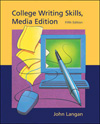
Activity 1: Time Order and Emphatic Order Part I Directions: The two methods of organization discussed in Chapter Four are
time order and emphatic order. Practice using time order
by writing an essay entitled "How to Write an Essay" describing your personal
method for getting the job done. Include at least three specific supporting
ideas in your paragraph.
Part II Directions: Next, practice using emphatic order by writing a paragraph
entitled "The Benefits of Being a Student" or "The Stresses of Living in [your
city or town]." Include at least three specific supporting ideas in your paragraph.
| 


 2003 McGraw-Hill Higher Education
2003 McGraw-Hill Higher Education